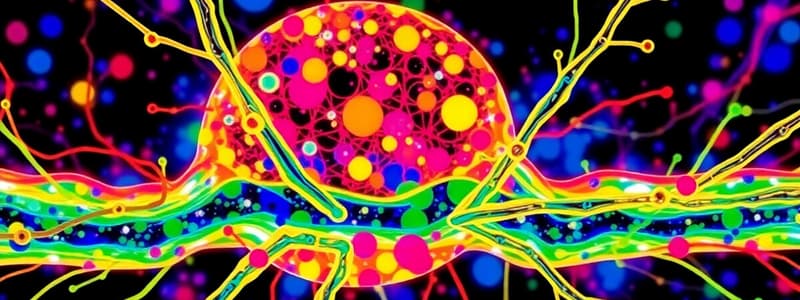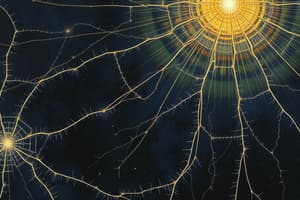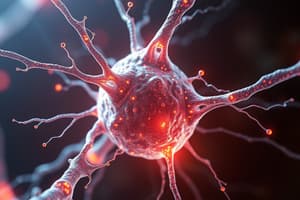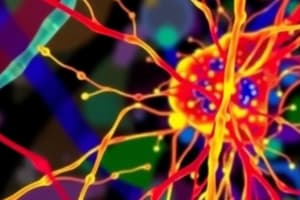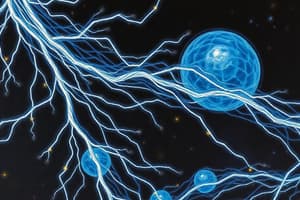Podcast
Questions and Answers
What is the structural relationship between alpha-tubulin and beta-tubulin?
What is the structural relationship between alpha-tubulin and beta-tubulin?
- They are isoforms of the same protein.
- They are separate proteins that do not interact.
- They form individual filaments that later combine.
- They combine to form a heterodimer subunit. (correct)
During microtubule polymerization, what happens to the GTP bound to beta-tubulin?
During microtubule polymerization, what happens to the GTP bound to beta-tubulin?
- It remains bound and is never hydrolyzed.
- It is released into the cytosol.
- It is exchanged for ATP.
- It is hydrolyzed to GDP. (correct)
What is 'dynamic instability' in the context of microtubules?
What is 'dynamic instability' in the context of microtubules?
- The ability to withstand mechanical stress.
- The constant state of depolymerization.
- The interaction with motor proteins.
- The switching between growth and shrinkage phases. (correct)
Which of the following is a direct consequence of the dynamic instability of microtubules?
Which of the following is a direct consequence of the dynamic instability of microtubules?
What determines the structural plasticity and dynamics of microtubules?
What determines the structural plasticity and dynamics of microtubules?
How does the addition of GTP-containing tubulin affect a protofilament?
How does the addition of GTP-containing tubulin affect a protofilament?
What occurs if GTP hydrolysis proceeds more rapidly than the addition of new subunits in a microtubule?
What occurs if GTP hydrolysis proceeds more rapidly than the addition of new subunits in a microtubule?
What is the function of the microtubule-organizing center (MTOC)?
What is the function of the microtubule-organizing center (MTOC)?
In animal cells, which structure is the major MTOC?
In animal cells, which structure is the major MTOC?
What is the role of microtubules during cell division?
What is the role of microtubules during cell division?
Which type of microtubule is directly involved in the alignment and segregation of chromosomes during cell division?
Which type of microtubule is directly involved in the alignment and segregation of chromosomes during cell division?
What is the primary function of microtubule-associated proteins (MAPs)?
What is the primary function of microtubule-associated proteins (MAPs)?
Which of the following motor proteins typically travels toward the (+) end of a microtubule?
Which of the following motor proteins typically travels toward the (+) end of a microtubule?
How does ATP hydrolysis contribute to the function of motor proteins like kinesin and dynein?
How does ATP hydrolysis contribute to the function of motor proteins like kinesin and dynein?
Which cellular component is transported toward the minus (-) end of microtubules by dynein?
Which cellular component is transported toward the minus (-) end of microtubules by dynein?
What role do MAPs play in cell polarization?
What role do MAPs play in cell polarization?
What is the structural basis for the movement of cilia and flagella?
What is the structural basis for the movement of cilia and flagella?
How do eukaryotic flagella differ from prokaryotic flagella in terms of structure?
How do eukaryotic flagella differ from prokaryotic flagella in terms of structure?
Which of the following best describes the function of cilia in respiratory epithelium?
Which of the following best describes the function of cilia in respiratory epithelium?
How does Taxol affect microtubules, and what is its clinical application?
How does Taxol affect microtubules, and what is its clinical application?
What is the mechanism of action of Vincristine on tumor cells?
What is the mechanism of action of Vincristine on tumor cells?
What effects does Colchicine have on microtubules and what condition is it used to treat?
What effects does Colchicine have on microtubules and what condition is it used to treat?
What is a key structural characteristic of intermediate filaments compared to microtubules and actin filaments?
What is a key structural characteristic of intermediate filaments compared to microtubules and actin filaments?
What is a primary role of intermediate filaments?
What is a primary role of intermediate filaments?
Which cellular structure is supported by intermediate filaments composed of lamins?
Which cellular structure is supported by intermediate filaments composed of lamins?
What is the function of intermediate filaments in epithelial cells?
What is the function of intermediate filaments in epithelial cells?
What structural feature is characteristic of intermediate filaments?
What structural feature is characteristic of intermediate filaments?
Which protein family is associated with intermediate filaments found in epithelial cells?
Which protein family is associated with intermediate filaments found in epithelial cells?
What causes epidermolysis bullosa simplex (EBS)?
What causes epidermolysis bullosa simplex (EBS)?
What is the cellular role of neurofilaments?
What is the cellular role of neurofilaments?
How many dimers are found in a final intermediate filament (IF) monomer?
How many dimers are found in a final intermediate filament (IF) monomer?
During microtubule depolymerization, what specific process allows beta-tubulin to polymerize once more?
During microtubule depolymerization, what specific process allows beta-tubulin to polymerize once more?
What is the composition called of very small cylindrical organelle near the nucleus in animal cells?
What is the composition called of very small cylindrical organelle near the nucleus in animal cells?
Knowing that microtubule dynamics play crucial roles for cell motility, impacting processes like wound healing and cancer metastasis, what result might oncologists expect to see when administering a microtubule-stabilizing agent versus a microtubule-destabilizing agent on cancer cell cultures?
Knowing that microtubule dynamics play crucial roles for cell motility, impacting processes like wound healing and cancer metastasis, what result might oncologists expect to see when administering a microtubule-stabilizing agent versus a microtubule-destabilizing agent on cancer cell cultures?
If a researcher discovers a new drug that inhibits the function of dynein, which cellular process would be MOST directly affected?
If a researcher discovers a new drug that inhibits the function of dynein, which cellular process would be MOST directly affected?
If you introduce a non-hydrolyzable analog of GTP into a cell, what would be the MOST likely effect on microtubule dynamics?
If you introduce a non-hydrolyzable analog of GTP into a cell, what would be the MOST likely effect on microtubule dynamics?
What is the effect of Latrunculin?
What is the effect of Latrunculin?
Desmin is a scaffold function involved?
Desmin is a scaffold function involved?
What is the purpose of intermediate filaments in the cytosol on the inside of a cell?
What is the purpose of intermediate filaments in the cytosol on the inside of a cell?
Flashcards
Microtubules
Microtubules
Polymers of the protein tubulin. They're hollow cylindrical structures built from heterodimeric protofilaments.
Tubulin Subunit
Tubulin Subunit
A heterodimer formed from two closely related globular proteins: alpha-tubulin and beta-tubulin.
Alpha-Tubulin GTP Binding
Alpha-Tubulin GTP Binding
The GTP bound to alpha-tubulin is trapped and not hydrolyzed or exchanged.
Beta-Tubulin GTP Hydrolysis
Beta-Tubulin GTP Hydrolysis
Signup and view all the flashcards
Dynamic instability
Dynamic instability
Signup and view all the flashcards
Microtubule Dynamics
Microtubule Dynamics
Signup and view all the flashcards
Microtubule Organizing Center (MTOC)
Microtubule Organizing Center (MTOC)
Signup and view all the flashcards
Centrosome
Centrosome
Signup and view all the flashcards
Bipolar Mitotic Spindle
Bipolar Mitotic Spindle
Signup and view all the flashcards
Microtubule-Associated Proteins (MAPs)
Microtubule-Associated Proteins (MAPs)
Signup and view all the flashcards
Kinesin
Kinesin
Signup and view all the flashcards
Dynein
Dynein
Signup and view all the flashcards
ATP hydrolysis
ATP hydrolysis
Signup and view all the flashcards
MAPs and pigment
MAPs and pigment
Signup and view all the flashcards
Microtubules
Microtubules
Signup and view all the flashcards
Taxol (Paclitaxel)
Taxol (Paclitaxel)
Signup and view all the flashcards
Vinca Alkaloids
Vinca Alkaloids
Signup and view all the flashcards
Colchicine
Colchicine
Signup and view all the flashcards
Intermediate Filaments
Intermediate Filaments
Signup and view all the flashcards
Role of intermediate filamnets
Role of intermediate filamnets
Signup and view all the flashcards
Cytosol structure
Cytosol structure
Signup and view all the flashcards
Keratinocyte
Keratinocyte
Signup and view all the flashcards
Epithelial Keratin Filaments
Epithelial Keratin Filaments
Signup and view all the flashcards
Clinical diversity
Clinical diversity
Signup and view all the flashcards
Keratin gene mutations
Keratin gene mutations
Signup and view all the flashcards
Neurofilaments
Neurofilaments
Signup and view all the flashcards
Lamin intermediate filaments
Lamin intermediate filaments
Signup and view all the flashcards
Desmin intermediate filaments
Desmin intermediate filaments
Signup and view all the flashcards
Study Notes
- Microtubules and intermediate filaments are components of the cytoskeleton, which also includes microfilaments.
Microtubules
- Microtubules are polymers made of the protein tubulin.
- Tubulin subunits are heterodimers formed from two closely related globular proteins: alpha-tubulin and beta-tubulin, each comprised of 445-450 amino acids.
- Each tubulin has one GTP binding site.
- GTP bound to alpha-tubulin is trapped and not hydrolyzed or exchanged.
- GTP in beta-tubulin is hydrolyzed to GDP during polymerization (growth).
- GDP reconverts to GTP when the microtubule depolymerizes (shrinks), allowing beta-tubulin to polymerize again.
- Microtubules are hollow cylindrical structures built from heterodimeric protofilaments.
- Microtubules have alpha-beta tubulin heterodimers that stack head to tail and fold into a tube.
- Dynamic instability is how microtubules grow (polymerize) and shrink (depolymerize).
- Dynamic instability involves microtubules switching between growth (assembly) and shrinkage (disassembly) phases.
- Microtubules can dynamically switch between growing and shrinking phases.
- Structural plasticity/dynamics relies on the GTP-binding domain activity in beta-tubulin.
- Adding GTP-containing tubulin to a protofilament end causes the end to polymerize (grow).
- Microtubules depolymerize (shrink) if GTP hydrolysis happens faster than adding new subunits
Clinical Relevance of Microtubules Dynamic Instability
- Cancer therapy drugs target microtubule dynamics, either stabilizing or destabilizing microtubules to disrupt mitosis and induce cell death.
- Microtubule-associated protein dysfunction leads to instability occurs in neurodegenerative diseases, This contributes to neurodegeneration.
- Therapies that modulate dynamics of microtubules and allow control tumor cell movement are used in cell migration and metastasis, processes like wound healing and cancer metastasis are impacted.
- Microtubule dynamics are essential for cell division and differentiation during development with disruptions potentially leading to developmental disorders
- Some pathogens exploit microtubule dynamics for entry and movement within host cells.
- Understanding these interactions can lead to new therapeutic approaches against infections.
- Microtubules originate from the microtubule organizing center (MTOC).
- In animal cells, the centrosome is the primary MTOC.
- The centrosome includes 2 cylinders called centrioles.
- Centrioles are small cylindrical organelles near the nucleus in animal cells, occurring in pairs and involved in spindle fiber development.
- When a cell divides, MTs rearrange to form a bipolar mitotic spindle.
- Bipolar mitotic spindle aligns and segregates chromosomes.
- Astral microtubules occur during this process
- After division, both daughter cells reorganize their MT and actin filaments.
Microtubule-Associated Proteins (MAPs)
- MAPs move along microtubules, transporting vesicles to target organelles in the cell.
- Kinesin typically travels towards the (+) end of the microtubule.
- Dynein typically travels towards the (-) end of the microtubule.
- ATP hydrolysis in the globular head domains generates movement along the microtubule via the microtubule-binding domains for kinesin and dynein
- Dynein includes two identical heavy chains to make large globular head domains, and a variable number of intermediate and light chains.
- Dynein transports intracellular cargos toward the (-) end of the microtubule.
- Kinesin shares a similar structure to dynein.
- Kinesin transports diverse intracellular cargoes to the (+) end of the microtubule, including vesicles, organelles, protein complexes, and mRNAs.
- Selective stabilization of microtubules can polarize a cell (+ end or – end).
- MAPs can move organelles and vesicles within the cell.
- Cell polarity represents spatial differences in shape, structure, and function within a cell.
- MAPs transport vesicles with pigments (melanosomes) in the skin.
Cilia and Flagella
- Microtubules play a structural role in eukaryotic cilia and flagella.
- Cilia and flagella both have highly specialized and efficient motility structures.
- Cilia and flagella contain a basal body with a microtubule base of 9:2 structure.
- Dynein motor proteins move along MT strands in the cilium/flagellum, bending and generating the force for movement.
- Prokaryotes have tubulin-like proteins, however, prokaryotic flagella differ from eukaryotic flagella because they do not contain MT-based structures.
- Flagella move cells in aqueous environments (e.g., spermatozoids).
- Cilia move fluid around a cell (e.g., mucus upwards in the respiratory epithelium).
Microtubule Specific Drugs
- Paclitaxel (Taxol): Prevents depolymerization of MT, decreasing dynamic nature of cytoskeletal structures
- Taxol is an anticancer chemotherapy drug
- Taxol is a cytostatic drug used in cancer therapy for breast/ovarian cancer
- Taxol inhibits mitotic cell progression to G1 phase via interference with spindle formation without affecting other microtubule function during anaphase/telophase
- Vinca Alkaloids (e.g., Vinblastin, Vincristine, Vindesin):
- Vincristine binds irreversibly to microtubules and spindle proteins
- This interferes with formation of the mitotic spindle, arresting tumor cells in metaphase
- Vinca alkaloids are found in periwinkles (Vinca rosae, Vinca minor)
- Binds free tubulin and prevents MT polymerization and cell division
- Used as cytostatic in treatments for Leukemia, Lymphoma, breast cancer
- Vincristine binds irreversibly to microtubules and spindle proteins
- Colchicine from alters tubulin in alkaloids the autumn crocus (Colchicum autumnale)
- Colchicine as a result, prevents MT polymerisation and cell division, demonstrating anti-inflammatory effects.
- Colchicine can aid in familial Shar-pei fever treatment
- Colchicine Prevents MT polymerization and consequently secretion of SAA (serum amyloid A – reactive amyloidosis) thus resulting in Disruption of moment of leukocytes and other inflammatory cells
Intermediate Filaments
-
No polarity (+) or (-) end exists on Intermediate Filaments
-
Subunits don't contain ATP or GTP
-
Intermediate filaments not involved in cell movement
-
No motor proteins associate
-
Intermediate filaments associate with cell-cell junctions strengthening cells and epithelia, tissue mechanical stability
-
It lines the inner face of the nuclear envelope, forming a protective cage for the cell's DNA
-
In the cytosol, they are twisted into strong cables
-
Bundles hold epithelial cells sheets together
-
Nerve cells extend long and robust axons
-
Hair and fingernails contain Intermediate Filaments
-
The central building block of Intermediate Filaments:
- two intertwined proteins = 'coiled-coil' dimer
- The building block are all bound together by hydrophobic interactions
-
In a final IF there are 16 dimers of IF monomers (=32 coiled coils)
-
Major Types of Intermediate Filament Proteins in Vertebrate Cells
- Nuclear :
- lamins A, B, and C- which helps to shape the nuclear lamina (inner lining of nuclear envelope)
- Vimentin-like- vimentin, which helps in:
- cells of mesenchymal origin to function,
- desmin to build muscle,
- glial fibrillary acidic protein to help glial cells (astrocytes and some Schwann cells) -peripherin also works in glial cells and some neurons
- Epithelial:
- type I keratins (acidic)
- type II keratins (basic) give rise to epithelial cells and their derivatives (e.g., hair and nails)
- Axonal:
- neurofilament proteins help neurons to operate.
- Nuclear :
-
Epithelial Keratin Filaments:
-
Includes the most diverse intermediate filament family
-
Produced by keratinocytes in the epidermis
-
Help in the Formation of horns, nails, hair, scales
-
Anchoring of epithelial cells occurs via desmosomes/hemidesmosomes
-
-
The diversity of keratins is clinically useful in diagnosis of
- Epithelial cancers (carcinoma)
- Particular set of keratin filaments expressed indicates epithelial tissue in which the cancer originated and thus guides the choice of treatment
- Ex Mutation in keratin genes causes genetic diseases of affecting various tissues-liver, intestines, skin
-
Gene Mutation causes various effects such as - Epidermolysis bullosa simplex (EBS), the final protein results in disruption of the keratin network in basal cells of the skin
- As a result, the epidermis detaches (blistering)
- EBS may arise from KRT5 missense variant in Cardigan Welsh Corgi or PLECnonsense variant.
- As a result, the epidermis detaches (blistering)
-
Vertebrate neurons make the neurofilament, helping the neurons to function- Participates(axonal growth) Participates in axonal growth (length and diameter)
- Neurofilaments give strength and stability to the axon for the neuron
Cytoskeleton - Summary
- Microfilaments
- Structure: Two helical crossed actin strands
- Diameter: 7-8 nm
- Subunit: Actin
- Functions: Cell shape maintenance, shape changes, muscle contraction, cell movement
- Localization: Periphery of the cell, sometimes running parallel
- Microtubules
- Structure: Tubes of 11-18 strands per MT
- Diameter: 24-25 nm with 15 nm Lumen
- Subunit: Tubulin (α- and β-Tubulin)
- Functions: Cell shape maintenance, chromosome movement during cell division, organelle movement, cell movement
- Localization: Coming from an organizing center (e.g., centrosomes) and spreading towards the cell periphery
- Intermediate Filaments
- Structure: Long molecule polymers
- Diameter: 8-12 nm
- Subunit: Keratin, Lamin, Vimentin
- Functions: Cell shape maintenance, mechanical strength, formation of nuclear lamina
- Localization: Distributed along the whole cytoplasm of the cell, building a network of filaments in the cytosol
Studying That Suits You
Use AI to generate personalized quizzes and flashcards to suit your learning preferences.
